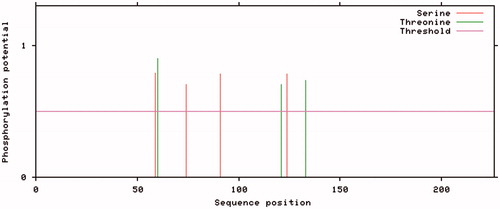Abstract
To explore the effects of the mutations of ATP6 and ATP8 genes on energy metabolism and genetic structure, we sequenced the ATP6 and ATP8 genes of Ailuropoda melanoleuca. Our results showed that ATP8 is a conserved gene and ATP6 gene is positively selected during the evolution of the giant panda population with a low genetic diversity. Population expansion was observed in the giant panda group. The T179C mutation on Haplotype7 made the production of a potential phosphorylation site. This non-synonymous mutation may occur at the post-translational modification site that have a potential effect on the function of ATP synthase, related to the maintenance of body temperature of pandas at low metabolic rates.
As the unique mutation of DUOX2 gene in giant panda (Ailuropoda melanoleuca) may explain these low thyroid hormone levels resulting a very low energy metabolism rate (Nie et al. Citation2015), the question how pandas maintain temperature under low metabolism rate was followed in this study. ATP synthase is core for oxidative phosphorylation, which also affect the normal body temperature (Elston et al. Citation1998). Proteins encoded by ATP6 and ATP8 featured prominently in ATP synthase as an indispensable part of the energy generation, thus we speculate that mutations of those two genes may trigger a series of biological problems. In this study, we aim to investigate the effects of the mutations in ATP6 and ATP8 genes on energy metabolism and genetic structure.
Blood samples were collected from 45 giant pandas in Wolong, Sichuan, China. Total genomic DNA was isolated using QIAamp DNA Blood Mini Kit (QIAGEN, Hilden, Germany). Primers for PCRs were designed according to GenBank (accession number: NC_009492.1).
The complete ATP8 (Genbank accession number: KY978453) and ATP6 (Genbank accession numbers: KY978454–KY978460) gene nucleotide sequences of giant panda are 204 bp and 681 bp with 49 bp overlap. No mutation observed in ATP8 indicating it was a conserved gene, this was consistent with Mishmar’s study (Mishmar et al. Citation2003) in human mtDNAs. ATP6 gene generated seven haplotypes (Haplotype1-7) based on its seven polymorphic sites (C120T, C166T, T179C, C390T, A418G, G637A, and T664A). Neutral test showed a population expansion in the giant panda group and the ATP6 gene was positively selected during the evolution. Among the five non-synonymous mutations, the T179C – making the Isoleucine on position 60 of the ATP6 protein mutanted to Serine – leads to the generation of a potential phosphorylation site on Haplotype7 (). Phosphorylation is one of the most important post-translational modification, involved in protein activation or inhibition in different cellular activities (Li et al. Citation2014). Non-synonymous mutations that occur at the post-translational modification site may have an effect on the associated modification function, resulting a change in protein function (Pan et al. Citation2014). Phosphorylation mutations in the ATP synthase β subunit affect the conformation of the F1 and decrease the catalytic activity of ATP synthase; The c subunit of F0 is also reported to be phosphorylated (Kane et al. Citation2010). Combined with the strong positive selection of the ATP6 gene above, We speculated these five non-synonymous mutations, especially the T179C on ATP6 gene may cause some altered ATP synthase function, which is likely to bring a change in the process of oxidative phosphorylation. Expression of ATP6 gene and disorder of oxidative phosphorylation are closely related to reactive oxidative species (ROS) level (Petros et al. Citation2005; Zhao et al. Citation2011). Simultaneously, ROS level regulates oxidative phosphorylation uncoupling, and controls basal metabolic heat production through proton leaks. Thus, the T179C on ATP6 gene was suspected to have relationship with the maintenance of body temperature in pandas at the situation low metabolic rates. Our study gives a possible reason for body temperature maintenance of pandas at low metabolic rates. However, due to the limitations of population in this study, the actual functional site and the specific impact on ATP synthase need further explored.
Disclosure statement
The authors report no conflicts of interest. The authors alone are responsible for the content and writing of the paper.
Additional information
Funding
References
- Elston T, Wang H, Oster G. 1998. Energy transduction in ATP synthase. Nature. 391:510–513.
- Kane LA, Youngman MJ, Jensen RE, Van Eyk JE. 2010. Phosphorylation of the F1Fo ATP synthase beta subunit functional and structural consequences assessed in a model system. Circ Res. 106:504–U541. English.
- Li J, Jia J, Li H, Yu J, Sun H, He Y, Lv D, Yang X, Glocker MO, Ma L, et al. 2014. SysPTM 2.0: an updated systematic resource for post-translational modification. Database: J Biol Databases Curation. 2014:bau025.
- Mishmar D, Ruiz-Pesini E, Golik P, Macaulay V, Clark AG, Hosseini S, Brandon M, Easley K, Chen E, Brown MD, et al. 2003. Natural selection shaped regional mtDNA variation in humans. Proc Natl Acad Sci USA. 100:171–176.
- Nie Y, Speakman JR, Wu Q, Zhang C, Hu Y, Xia M, Yan L, Hambly C, Wang L, Wei W, et al. 2015. Animal physiology. Exceptionally low daily energy expenditure in the bamboo-eating giant panda. Science. 349:171–174.
- Pan Y, Karagiannis K, Zhang H, Dingerdissen H, Shamsaddini A, Wan Q, Simonyan V, Mazumder R. 2014. Human germline and pan-cancer variomes and their distinct functional profiles. Nucleic Acids Res. 42:11570–11588.
- Petros JA, Baumann AK, Ruiz-Pesini E, Amin MB, Sun CQ, Hall J, Lim S, Issa MM, Flanders WD, Hosseini SH, et al. 2005. mtDNA mutations increase tumorigenicity in prostate cancer. Proc Natl Acad Sci USA. 102:719–724.
- Zhao XM, Du WH, Wang D, Hao HS, Liu Y, Qin T, Zhu HB. 2011. Recovery of mitochondrial function and endogenous antioxidant systems in vitrified bovine oocytes during extended in vitro culture. Mol Reprod Dev. 78:942–950.

